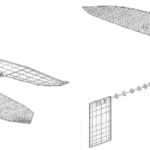Paper, Flight dynamics of a pterosaur-inspired aircraft utilizing a variable-placement vertical tail
Mission performance for small aircraft is often dependent on the turn radius. Various biologically inspired concepts have demonstrated that performance can be improved by morphing the wings in a manner similar to birds and bats; however, the morphing of the vertical tail has received less attention since neither birds nor bats have an appreciable vertical tail. This paper investigates a design that incorporates the morphing of the vertical tail based on the cranial crest of a pterosaur. The aerodynamics demonstrate a reduction in the turn radius of 14% when placing the tail over the nose in comparison to a traditional aft-placed vertical tail. The flight dynamics associated with this configuration has unique characteristics such as a Dutch-roll mode with excessive roll motion and a skid divergence that replaces the roll convergence.
Learn about our two Decals!
 Click here to find out more about our Fall Bioinspired Design Decal and our Spring Bioinspired Design in Action Decal – ALL MAJORS are welcome.
Click here to find out more about our Fall Bioinspired Design Decal and our Spring Bioinspired Design in Action Decal – ALL MAJORS are welcome.Berkeley BioDesign Community
 Click here to learn about the BioD: Bio-Inspired Design @ Berkeley student organization or here to signup for more info.
Click here to learn about the BioD: Bio-Inspired Design @ Berkeley student organization or here to signup for more info.Search
Student Login




I imagine that the neurological circuits underlying these processes are governed by both 2d spacing maps with their brains as…
to reduce the impact of car accidents, it may be possible to study the force diverting physics of cockroaches to…
you see this type of head-bobbing stability in many avian creatures related to pigeons like chickens. the head ability to…
not like they taught horses how to run! this is an example of convergent evolution where both sea creatures and…
The brain functions in a similar way with neuronal connections. our brains are able to utilize the multiplicity of connections…